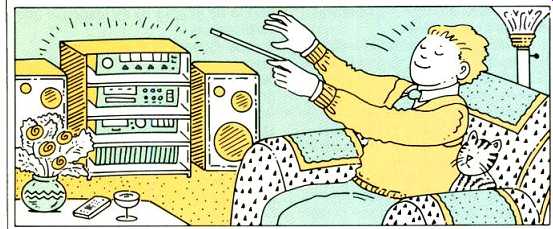MUSIC AND MUTABILITY

Genuine Synthesis
It's a surprisingly short step between digital sound production and reproduction. Some synthesizers can already digitize natural sounds, analyze them, alter their sound patterns to yield sonic mutations, or combine them with others to produce hybrids. Given pre-digitized sounds on CD, home audio systems with digital-to-analog conversion, and computing power that grows ever less expensive, it's just a matter of time until our stereo systems become capable of such audio genetics.
Back in 1969, long before all these revolutions in digital audio and low cost computing, I wrote a piece for Esquire predicting that "the hi-fi system of the not-so-distant future" would include a piano-like synthesizer with a video "music stand" to display the musical score as it played (a feature of several modern synthesizers). I also predicted that it wouldn't reproduce music at all.
Instead, it would produce music, using that same synthesizer. What the system played would not be audio recordings of the music's sound, but data recordings of the sound's makeup-instructions from which the synthesizer could re-create that sound.
The user would be able to reprogram the synthesizer's response to those instructions, so as to electronically transcribe music written for one instrument to sound as if it were being played by another (there are already synthesizers which can store and substitute sounds this way, or so I understand). The user would also be able to dial in tempo changes, and even changes in hall sound. The ultimate (an idea I added in a later article) would be "personality modules" that mimicked human personalities, so one performer's interpretation, or even voice, could be substituted for another's. (Teresa Brewer sings "Carmen"? Janis Joplin as Medea? Furtwangler conducts Varese? Hmmm ...) With appropriate sensors, you might even get your system to respond to your baton as you conducted.
The dark side is that any musical perversions you could cook up temporarily at home (Alvin and The Chipmunks sing Ned Rorem ...) could be cooked up just as easily, and stored on record for all time, by equally perverted record producers and they'd have the facilities first. But given time, and the general trend of professional computing power to drift into our homes, we'll eventually be able to undo all that stuff too.
Thunder Strike

More than a year ago, Telarc announced a forthcoming CD of Ferde Grofe's "Grand Canyon Suite." The orchestral parts were recorded by Erich Kunzel and the Cincinnati Pops back in 1983, but the disc has not yet appeared. The problem is that Telarc's CDs are all-digital, on principle, and the company could find no suitable digital recordings of Grand Canyon thunder. They've sent out several thunder-chasing explosions with portable digital taping gear, but without usable results so far.
When I first heard this, I thought that the thunder, instead of striking, had gone out on strike. It turns out that the problems have been more prosaic: It's hard to get the sound of thunder without rain. It's almost as hard, these civilized days, to get it without noise from traffic, airplanes and people; at the Grand Canyon Aself, this proved impossible. Moreover, thunder comes with lightning--and that can interfere with recording gear.
Anyone out there have a good, quiet, digital thunderstorm? Or know how to start a storm on cue? Telarc would probably like to hear from you.
Fright to the Finnish
Radio apparently still has the same kind of power to catch the listener's imagination that it had when Orson Welles broadcast a radio play of H. G. Wells' The War of the Worlds in 1938. As Edward Tatnall Canby has pointed out in some recent columns, that broadcast convinced thousands of listeners-chiefly those who tuned in after the opening announcements that Martians had landed and were conquering the world.
Last December, a radio play about nuclear war engendered similar mass hysteria when it was broadcast in Finland. According to a Reuters dispatch in The Washington Post, switchboards were jammed with calls and health centers treated listeners for shock, despite reminders during the drama (as well as before and after) that it was all fiction. The Post story mentioned that the play, The Next War, was written in the U.S. and won awards as the best American radio play of 1984.
Coda: A. Stewart Hegeman
Noted audio designer A. Stewart Hegeman died on August 19 at the age of 72. The man whom everyone called Stew was brilliant, salty, warm and cantankerous, intellectually stimulating, and a lot of fun to know.
He never had his name on a big company, and did his most important work before the current era of designer--as-hero. But his work was important nonetheless.
He was one of the first to advocate bandwidths beyond the proverbial "20 to 20,000." The original Citation amplifier line, which he designed for Harman/Kardon, popularized the concept and practice of ultra-wide-bandwidth amplification; compare the bandwidth figures given in our October Directory with those of the early '60s, when the Citation line appeared, and you'll see one of his legacies.
Another Hegeman legacy is the phrase "a straight wire with gain," which summed up his amplifier philosophy--since adopted by many amplifier makers and parroted by even more. It's flattering to have one's words prove so true that they become clichés, but Stew was more annoyed than flattered by it.
His omnidirectional "ice cream cone" tweeter of the 1950s demonstrated the importance of wide-dispersion speaker design and inspired AR's dome tweeter. "One of his great contributions to the field," says AR founder Edgar Villchur, "was making people understand that you couldn't judge a speaker by its on axis response alone-that a speaker had to be judged by its response and its dispersion." Stew pioneered in many other areas: In the 1950s, he designed laminated-cone speakers, one of the first stereo preamps, and some of the first transistor audio components; he also helped produce limited-edition audiophile discs ( Westminster's Lab Series). In the '60s, he designed the first Dynatuner--so good it was produced for 15 years-and the Citation line. Later he produced speakers, amps and preamps under his own name; two of his later omni speakers are still being produced, by Morrison Audio in Toronto.
This list of accomplishments is not complete. Stew didn't keep lists of bygone triumphs or even mention them; even his wife only learned recently, by accident, that he had been commended for his defense electronics work in World War II.
Like most good audio designers, Stew was more interested in music than in audio per se. He liked to listen to it, record it, and make sure it was reproduced as well as possible. Stew was also active in the Catgut Acoustical Society, a group researching the design of stringed instruments. He will be missed.
CD Graphics
The prospects of graphics on CD are looking up. Many new players include subcode outputs which can feed data to graphics adaptors;
Toshiba and Sony will probably be first on the market with the adaptors themselves. The standards allow for a palette of 4,096 possible colors, of which only 16 can be used at once.
The display, consisting of 288 x 192 picture elements (pixels), is visibly cruder than broadcast TV (340 x 340 on the screen of a good modern TV set), or even a VCR at slow speed (240 x 340). According to JEI, a Japanese trade magazine, about 2,000 such images can fit onto a CD along with the music. (Presumably, there will be fewer images on most recordings, which are shorter than the CD's 75-minute maximum.) The images will change every 2.25 seconds or so, more like a fast slide show than TV.
Bowing Out
Two long-familiar names in home audio won't be making home audio anymore. Crown International of Elkhart, Ind. has discontinued its home high-fidelity product line in order to concentrate on its professional and commercial microphone and amplifier products.
Heath, of Benton Harbor, Mich., has discontinued all its audio products except a half-octave real-time spectrum analyzer, though it will continue to make computers and other kits.
I'll miss both companies. The first audio-equipment catalog I ever saw was Heath's, and the first separate amp and preamp I ever owned were Heath's gold-finished W-5M and WAP-2. The W-5M was, as I recall, the amp that broke the dollar-per-watt barrier, back in the '50s (it was a massive 25-watter too). The WAP-2 preamp's phono-equalization stage had adjustable turnover and roll-off controls so one could match the many record equalization curves used in those pre-RIAA days. Since I still have many of those old records, I wish I also still had that preamp though, since it took its power from that long-gone amplifier, I'd need some way to power it.
When I got into tape recording, I longed for a big Crown deck, more portable and affordable than the Ampex 350-but not quite affordable enough for me, alas.
Both companies followed unusual routes into home audio. Heath started as an aircraft company, making the Heath Parasol in both kit and factory-built form. In World War II they made defense electronics, then shifted to civilian electronic kits. Crown originally made tape recorders for use by missionaries engaged in gospel broadcasting, then enlarged their market.
(adapted from Audio magazine, Nov. 1986)
= = = =